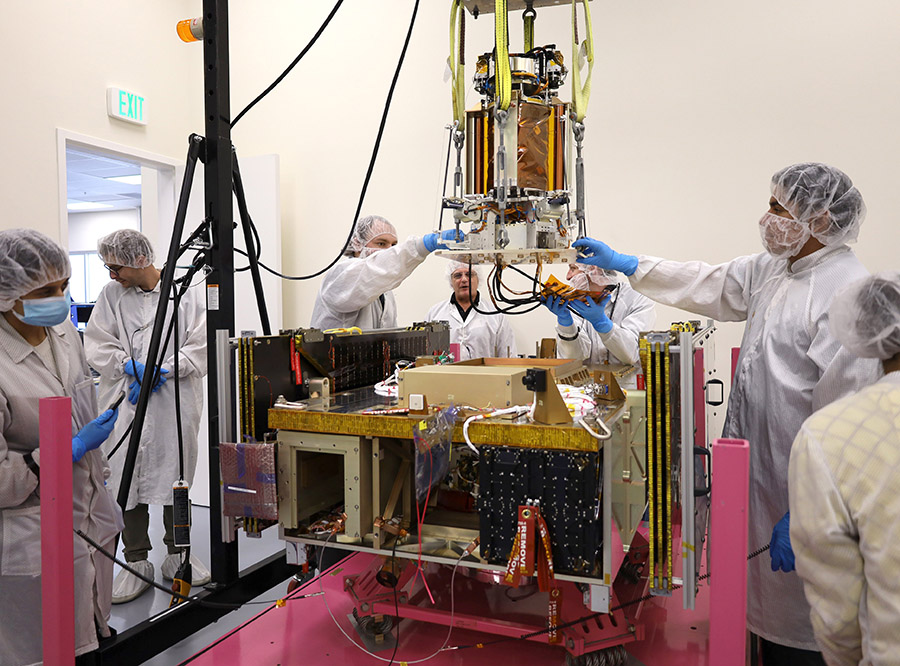Solar Energy from Space
In April 2023, we reported on the global efforts to produce solar energy in space. And just one year later, some important milestones have been achieved.
On the evening of May 22, 2023, four people sat on a rooftop of the California Institute of Technology and waited, as Caltech Magazine so poetically describes, for a sign from the heavens.
At around 10 p.m., they turned their attention to a monitor. The time frame for something to happen was seven minutes. And just a few nerve-racking moments later, a small peak appeared on the screen – and behaved exactly as predicted.
This was proof that the university’s Space-Based Solar Power Project (SPSP) had succeeded not only in transmitting solar energy produced by a PV module in space to a transmitter aimed at the Earth, but also ensuring that this energy can actually be registered here on Earth too.
Practical test in orbit
One year earlier, a SpaceX rocket had sent the Space Solar Power Demonstrator (SSPD-1) into orbit. It is a prototype of the system that the Caltech team has been working on for over a decade.
Generating solar power with photovoltaic cells, transmitting it to the destination in the form of microwave energy and converting it back to electricity when it gets there is the basic principle behind almost all space photovoltaics projects. The main aim of the research group at the California Institute of Technology is to find a cost-effective solution. This will be made possible thanks to ultra-lightweight components for three pieces of technology.
The spacecraft housing the power plant is made of ultra-thin composite materials and polymer films that unfold in space. Thanks to new materials, structures and manufacturing processes, the photovoltaics are capable of delivering exceptionally high performance in relation to their weight. The third key technology that was tested on the Space Solar Power Demonstrator is an arrangement of microwave transmitters, which are also extremely lightweight and responsible for radiating the generated energy to a particular destination.
Ultimately, the system needs to be as compact and lightweight as possible. This is because one major challenge of space photovoltaics is the process of transporting the equipment into space and the fuel consumption this would entail.


The highlight of the evening
How the three components of the Caltech system function both individually and in combination under the harsh conditions of space are questions to which the space-based prototypes should provide answers. Future Caltech-type systems would have to cope with significant temperature fluctuations and the permanent solar radiation in space.
It became clear quite quickly that not only did the solar cells produce electricity but also that this energy was successfully transmitted between two points in space. “We had, of course, tested it down here first,” Professor Ali Hajimiri, who leads the SPSP project, explained in Caltech Magazine. “But now we know that the system can survive the journey into space and function up there.”
The ultimate challenge was to direct the energy toward the Earth. For Ali Hajimiri, this was the highlight of the evening: “To our knowledge, no one has demonstrated wireless energy transmission in space yet, not even using expensive rigid structures. We achieved this using flexible lightweight structures and our proprietary integrated circuits. This is unprecedented.”
The various functional areas of the Caltech project are tested on the SPSP test bench up in space: lightweight design, solar cells and wireless transmission.
One step closer to the vision
In the months following the rooftop party, the researchers tested factors such as the efficiency, durability and functionality of a collection of 32 different solar cells on their floating test bench. They asked themselves whether the lightweight design would withstand the harsh conditions of space. And in January 2024, Caltech officially announced the successful completion of this series of tests.
This brought the SPSP team one step closer to their vision of creating a fleet of floating small-scale power plants that they can join together to form a “swarm” as needed. Each shuttle would be equipped with a flexible, ultra-lightweight membrane capable not only of generating electricity but also transmitting it to the destination in the form of microwave energy.
That would represent a huge leap in terms of development. Solar energy is already being produced in space to supply satellites and the international space station, but the processes involved are just not that efficient. Launching solar cells with a typical output of around 200 W in space costs $10,000 per square meter. For their system, the Caltech researchers are aiming to achieve a performance level many times greater than the surface area.

“Solar energy from space – a hot topic that we at SMA Innovation Management definitely have on our radars. Whether and when SMA technology will actually contribute to the energy supply from space is still written in the stars. But who knows? At the current development rate, it’s definitely on our longlist.”
– Carsten Gundlach, Senior Innovation Manager at SMA Solar Technology AG
ESA is aiming for the moon
Solaris, the space-based solar power project of the European Space Agency (ESA), is also continuing its work. A Call for bids on the proprietary open innovation platform OSIP yielded a series of concept studies on solar energy from space, which have now been granted official approval for further research. They include approaches to dealing with obsolete technology, cheaper and more lightweight construction methods and electricity for the moon. Although the aim here is not to supply the Earth with solar power but rather to generate energy for future manned lunar bases, the resources required would mainly come from the moon itself and the solar cells would even be manufactured there. So if you thought that only artificial intelligence could make such incredible leaps within a single year, space projects are also moving at the speed of light.

